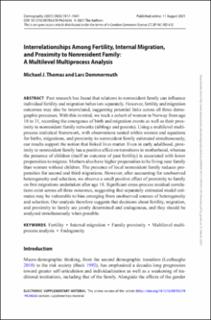| dc.contributor.author | Thomas, Michael J. | |
| dc.contributor.author | Dommermuth, Lars | |
| dc.date.accessioned | 2022-03-22T19:31:17Z | |
| dc.date.available | 2022-03-22T19:31:17Z | |
| dc.date.created | 2021-08-17T10:45:55Z | |
| dc.date.issued | 2021 | |
| dc.identifier.citation | Demography. 2021, 58 (5), 1817-1841. | en_US |
| dc.identifier.issn | 0070-3370 | |
| dc.identifier.uri | https://hdl.handle.net/11250/2986909 | |
| dc.description.abstract | Past research has found that relations to nonresident family can influence individual fertility and migration behaviors separately. However, fertility and migration outcomes may also be interrelated, suggesting potential links across all three demographic processes. With this in mind, we track a cohort of women in Norway from age 18 to 31, recording the emergence of birth and migration events as well as their proximity to nonresident family networks (siblings and parents). Using a multilevel multiprocess statistical framework, with observations nested within women and equations for births, migrations, and proximity to nonresident family estimated simultaneously, our results support the notion that linked lives matter. Even in early adulthood, proximity to nonresident family has a positive effect on transitions to motherhood, whereas the presence of children (itself an outcome of past fertility) is associated with lower propensities to migrate. Mothers also have higher propensities to be living near family than women without children. The presence of local nonresident family reduces propensities for second and third migrations. However, after accounting for unobserved heterogeneity and selection, we observe a small positive effect of proximity to family on first migrations undertaken after age 18. Significant cross-process residual correlations exist across all three outcomes, suggesting that separately estimated model estimates may be vulnerable to bias emerging from unobserved sources of heterogeneity and selection. Our analysis therefore suggests that decisions about fertility, migration, and proximity to family are jointly determined and endogenous, and they should be analyzed simultaneously when possible. | en_US |
| dc.language.iso | eng | en_US |
| dc.publisher | Duke University Press | en_US |
| dc.rights | Navngivelse-Ikkekommersiell-DelPåSammeVilkår 4.0 Internasjonal | * |
| dc.rights.uri | http://creativecommons.org/licenses/by-nc-sa/4.0/deed.no | * |
| dc.title | Interrelationships among fertility, internal migration, and proximity to nonresident family: A multilevel multiprocess analysis | en_US |
| dc.type | Peer reviewed | en_US |
| dc.type | Journal article | en_US |
| dc.description.version | publishedVersion | en_US |
| dc.rights.holder | This is an open access article distributed under the terms of a Creative Commons license (CC BY-NC-ND 4.0). | en_US |
| dc.subject.nsi | VDP::Samfunnsvitenskap: 200::Demografi: 300 | en_US |
| dc.source.pagenumber | 1817-1841 | en_US |
| dc.source.volume | 58 | en_US |
| dc.source.journal | Demography | en_US |
| dc.source.issue | 5 | en_US |
| dc.identifier.doi | 10.1215/00703370-9424636 | |
| dc.identifier.cristin | 1926563 | |
| dc.relation.project | EU – Horisont Europa (EC/HEU): 740113 | en_US |
| cristin.ispublished | true | |
| cristin.fulltext | original | |
| cristin.fulltext | original | |
| cristin.qualitycode | 2 | |

